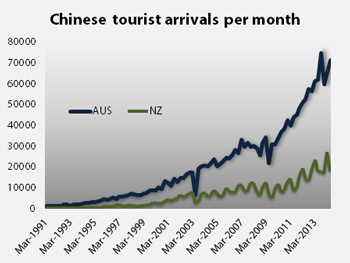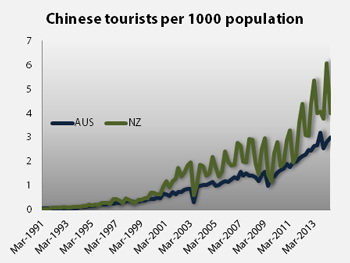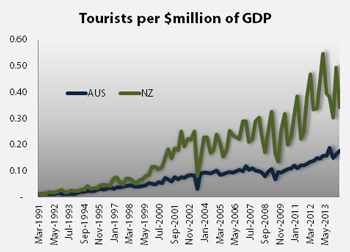-
Dad, Where Are We Going? The answer to that question could be crucial to the economic future of Australia and New Zealand.
Dad, Where Are We Going? is the title of a Chinese TV show starring five children and their celebrity dads.
"The potential for growth remains huge. So Australia and New Zealand are locked in a battle for [Chinese tourists] hearts and wallets."
Jason Murphy, Publisher, Thomas the Think EngineEach episode, three actors, a singer and a gold-medal winning gymnast take their children to enviable travel locations. It’s a ratings mega-hit, with each episode reaching 75 million viewers. The dads and their kids have always enjoyed visiting parts of China.
But in the most recent episodes that has dramatically changed. Suddenly Yang Yangyang, his dad, and all the rest are tromping around New Zealand. Aotearoa is being beamed into millions of lounge rooms.
This is a PR coup of immense proportions.
Tourism accounts for an estimated 9 per cent of the global economy, according to the UN’s World Tourism Organisation. Globally, tourism numbers have gone from 25 million in 1950 to 1087 million in 2013. Chinese outbound tourism is both the biggest and fastest growing sector.
The UN reports that Chinese tourists spent more than any other group in 2013, at $129 billion.
The economic clout of these tourists is enough to make any country richer. But just five per cent of Chinese people have passports. The potential for growth remains huge. So Australia and New Zealand are locked in a battle for their hearts and wallets.



Australia looks - at first glance - to be winning by a lot.
But raw data can hide as much as it reveals. In some important ways, NZ is ahead.
The economic impact of tourism is ultimately its impact on the earnings of people and households. So the tourism per capita measure is a crucial one.
Taking into account New Zealand’s smaller economy, the rush of Chinese tourists looks even stronger. (Note the recent fall in the cross-Tasman exchange rate has played a major part in preventing the green line on this graph from shooting up.)
NZ punches about its weight in many categories, but most of all by land mass. NZ leaves Australia in the dust.
Since Chinese tourists are often in the antipodes to see natural features, this measure could work either way. If Australia seems bleak, featureless or hard to get around that won’t help it grab tourist expenditure. But if it makes Australia seem uncrowded, that could help it.
Tourism Australia research shows that Chinese tourists value landscape. “World class beauty and natural features” was the top response in a major recent survey of Chinese tourists when asked what they were looking for in a holiday destination. Food, wine and produce came second, while safety was a close third.
Both Australia and New Zealand have a lot to offer in those three categories. But neither can make Chinese tourists enjoy great scenery if they’re still fuming from a terrible accommodation experience.
Tourism Australia research shows the single most important category for Chinese tourists is also the one in which accommodation providers most need to improve – language.
80 per cent of tourists said international hotels needed to lift their game in terms of providing Mandarin-speaking staff and translated travel and tourism guides.
This is a big issue. As Chinese tourists shake the shackles of the tour group and do more independent travel, they are more and more likely to find themselves in situations where Mandarin is a fruit, not a lingua franca.
But if we can make progress on this front, the antipodes is extremely well-placed to profit.
Australia is ranked first on Chinese people’s wishlists for travel, ahead of France and NZ. Australia has built its early lead with great marketing, including the website Australia.cn.
But New Zealand is manoeuvring cleverly. Dad, Where are we going? is not their only media tie-in.
The Hobbit was one of just 34 western films released in China in 2013, meaning New Zealand’s Middle-earth branding now makes sense in that market.
(Meanwhile, the most popular Australian film ever released in China is Bait, a horror-comedy about a shark chasing people around a flooded supermarket. Tourism Australia’s marketing people are presumably pulling their hair out.)
NZ has needed to work that little bit harder than Australia to win Chinese visitors, since it is further away. In recent times, it looks like that hard work is paying off.
But paradoxically, if NZ attracts a flood of visitors, that could end up working in Australia’s favour. For now, most Chinese tourists who visit NZ also tack on a visit to Australia. So the answer to Dad, Where Are We Going? might be: Both.
Jason Murphy publishes the highly popular blog Thomas the Think Engine and is a former writer for The Australian FinanciaL Review.
The views and opinions expressed in this communication are those of the author and may not necessarily state or reflect those of ANZ.
anzcomau:Bluenotes/asia-pacific-region,anzcomau:Bluenotes/asia-pacific-region/culture
Kiwi vs Shark: The great antipodean tourist battle
2014-12-12
/content/dam/anzcomau/bluenotes/images/articles/2014/December/Hobbiton_banner.png
